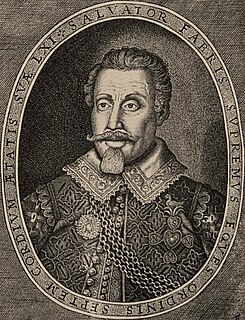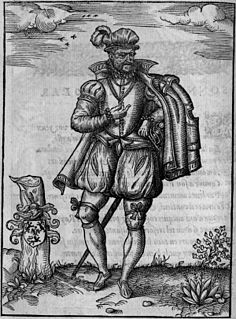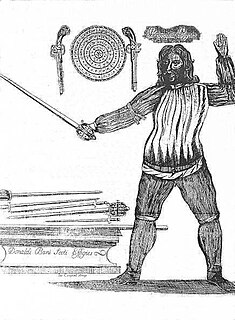Related Research Articles

A rapier or espada ropera is a type of sword with a slender and sharply-pointed two-edged blade that was popular in Western Europe, both for civilian use and as a military side arm, throughout the 16th and 17th centuries.

Historical European martial arts (HEMA) are martial arts of European origin, particularly using arts formerly practised, but having since died out or evolved into very different forms.
Martial arts manuals are instructions, with or without illustrations, specifically designed to be learnt from a book. Many books detailing specific techniques of martial arts are often erroneously called manuals but were written as treatises.

Domenico Zampieri, known by the diminutive Domenichino after his shortness, was an Italian Baroque painter of the Bolognese School of painters.

Jean-Nicolas Servan, also known as Giovanni Niccolò Servandoni was an Italian decorator, architect, scene-painter, firework designer and trompe-l'œil specialist.

The term Italian school of swordsmanship is used to describe the Italian style of fencing and edged-weapon combat from the time of the first extant Italian swordsmanship treatise (1409) to the days of Classical Fencing.

Louis-Jean-François Lagrenée was a French rococo painter and student of Carle van Loo. He won the Grand Prix de Rome for painting in 1749 and was elected a member of the Académie royale de peinture et de sculpture in 1755. His younger brother Jean-Jacques Lagrenée was also a painter.

Salvator Fabris (1544-1618) was an Italian fencing master from Padua. During his life he taught in various European countries, most notably in Denmark where he was the fencing instructor of King Christian IV. It was during his time in Copenhagen that he published his treatise on rapier fencing, Lo Schermo, overo Scienza d’Arme, in 1606. The treatise became a fencing bestseller around Europe, and was reprinted until 1713 and translated into several languages, notably into German, and again in 2005, into English.

The known history of fencing in France begins in the 16th century, with the adoption of Italian styles of fencing.
Giovanni Girolamo Kapsperger was an Austrian-Italian virtuoso performer and composer of the early Baroque period. A prolific and highly original composer, Kapsberger is chiefly remembered today for his lute and theorbo (chitarrone) music, which was seminal in the development of these as solo instruments.
Bolognese Swordsmanship, also sometimes known as the Dardi school, is a tradition within the Italian school of swordsmanship which is based on the surviving fencing treatises published by several 16th century fencing masters of Bologna, As early as the 14th century several fencing masters were living and teaching in the city: a maestro Rosolino in 1338, a maestro Nerio in 1354, and a maestro Francesco in 1385.
The decade of the 1530s in music involved some significant events, publications, compositions, births, and deaths.
The oldest surviving manual on western swordsmanship dates back to the 14th century, although historical references date fencing schools back to the 12th century.

Monsieur d'Orléans was the second son and fourth child of Henry IV of France and his consort, Marie de' Medici. Commonly ascribed the names Nicolas or Nicolas Henri and the title Duke of Orléans, he was neither baptised nor invested as such during the course of his short life.

Hieronymus Galle or Hieronymus Galle I or the Elder was a Flemish painter, who specialized in still lifes of fruit and flowers and hunting pieces. He collaborated with his fellow painters on garland paintings, i.e. paintings showing a garland of flowers or fruit around a devotional image or portrait.
François Dancie was a French fencing instructor who wrote two treaties in the seventeenth century. He was a gentleman of Limousin in central France. He may be François Dancie of Nonards, recorded as marrying Jeanne de Linnars, daughter of Jacques de Linnars, Judge of Bretenaux. Jeanne’s brother Jean was married to Marie de Maynard, daughter of Géraud de Maynard, counsellor to the Parliament of Toulouse, and also sister to the poet François de Maynard, who wrote a poem for Dancie’s publication of 1623.

The Renaissance Sword Club is a historical European martial arts group based in London, South East of England and Brittany, France. It was founded in 2013 by Rob Runacres. Its primary aim is the research and recreation of European swordsmanship of the sixteenth and seventeenth centuries, specifically those concerned with the rapier and spada da lato, as well as their companion weapons such as the dagger, cloak, buckler and rotella. Members have also pursued interests outside of the core curriculum in to staff weapons, longsword and small sword.

Masters of Defence or Masters of Fencing is a widespread guild of teachers specializing in close combat military techniques with weapons, civilian fighting skills, and unarmed combat. The title was coined during the Medieval period, and referred to men who were particularly skilled at the art of fighting.

Donald McBane was a noted Scottish swordsman, career soldier, and fencing master, who is widely regarded as one of the most prolific duelists of all time. He was born in the Highland town of Inverness during the late seventeenth century. In 1687 McBane ran away from home, enlisting in the British army under the Duke of Marlborough. As a career soldier, he served throughout much of Europe, fighting in The War of the Spanish Succession (1701-1714), and taking part in fifteen skirmishes and sixteen battles, including Blenheim (1704) and Malplaquet (1709). By the time of the Jacobite Rising of 1715, he was serving as a Sergeant in General Honeywood’s Regiment of Dragoons and guarded the Colours at the Battle of Preston. His autobiography mentions that at one point he had the command responsibility equivalent to a Colonel of Artillery, but it is unlikely he ever received an officer's commission. His Colonel made several recommendations for McBane to 'Chailcie College', something only open to senior non-commissioned or Warrant Officers.

The Greatness of the Sword is a XVI century Spanish treatise on fencing written by Don Luis Pacheco de Narvaez, who is considered one of the founding fathers of Spanish fencing “Destreza”, the disciple of Jerónimo de Carranza.
References
- ↑ [Castle, E. Egerton Schools and Masters of Fencing: From the Middle Ages to the Eighteenth Century, 2003, p.105]
- ↑ [Briorst P., Drevillon H. & Serna P, Croiser le fer: Violence et culture de l'épée dans la France modern, 2002 p.66]
- ↑ [Brantome, Discours sur les duels, 1997, p.199]
- ↑ [Héroard, Jean, Journal de Jean Héroard sur l'enfance et la jeunesse de Louis XIII (1601-1628)]